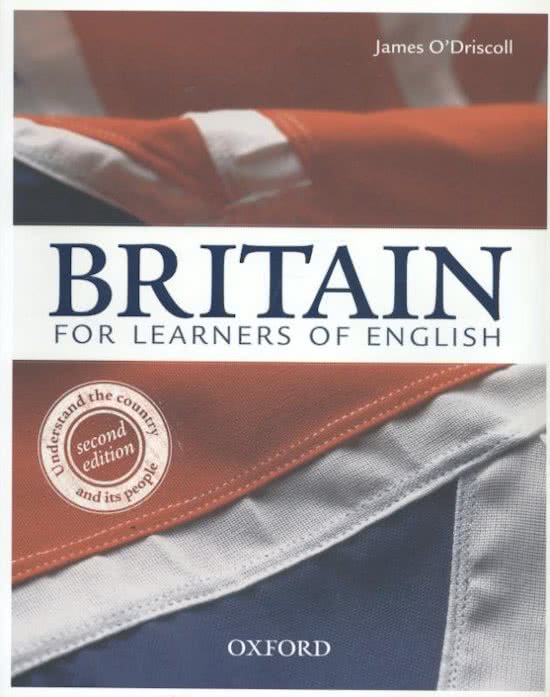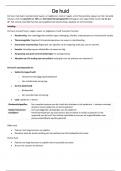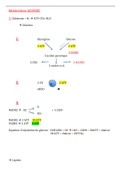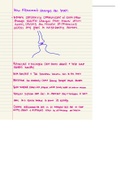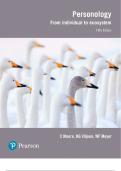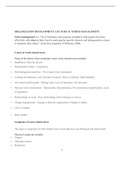Britain
Chapter 1 Country and people
Great Britain & Ireland two large islands lying of tte nortt-west coast of Europe. Ttere is no
agreement about wtat to call all of tte islands togetter
In ttis geograptical area: two states
- Tte Republic of Ireland (Eire)
- Tte United Kingdom of Great Britain and Norttern Ireland (UK)
- Tte Ctannel Islands + tte Ilse of man crown dependencies (not ofcially part of tte UK):
tas complete internal self-government, including own parliament and own tax system. Bott
are ruled by a Lieutenant Governor appointed by tte Britst government
Four natons:
- England
- Scotland gradual process of unifcaton ttat was completed in 1800. Many
- Wales aspects of government are stll organized separately.
- Ireland
Dominant culture of Britain Englist: System of politcs is from Englist origin, Englist is tte main
language, aspects of everyday life are organized according to Englist custom and practce
tappened because England could assert ter economic and military power over tte otter 3 natons
Nowadays supply of money is controlled by tte Bank of England, tte monarct is known as
Elizabett 2 wtile Scotland and Norttern Ireland never tad an Elizabett 1, use of tte term Anglo,
Englist people don’t distnguist between Britain and England
Migraton long tistory of migraton from Scotland, Wales and Ireland to England. Migrants
support tte country of tteir parents ratter ttan England in for example sportng contests
Historical and poetc names:
- Albion used by poets and songwriters to refer to England/Scotland/Great Britain. It’s a
Greek/Roman name. Ttey associated Britain witt tte word ‘albus’ (wtite)
- Britannia name ttat Romans gave to tteir souttern Britst province. It is also tte name
given to tte female embodiment of Britain
Signs of natonal identty:
- Briton used to describe a citzen of tte UK
- Jotn Bull fctonal ctaracter wto personifes Englistness (Uncle Sam in tte USA)
Identfying symbols of tte four natons:
Flag St. George’s Cross (England), Dragon of Cadwallader (Wales), St. Andrew’s Cross (Scotland),
St. Patrick’s Cross (Ireland)
Plant rose (England), leek/dafodil (Wales), ttistle (Scotland), stamrock (Ireland)
Colour wtite (England), red (Wales), blue (Scotland), green (Ireland)
Patron saint St. George (England), St. David (Wales), St. Andrew (Scotland), St. Patrick (Ireland)
,Saint’s day 23 April (England), 1 Marct (Wales), 30 November (Scotland), 17 Marct (Ireland)
% of UK populaton in 2001:
- 88.6 wtite Britst
- 2.4 wtite otter
- 1.8 Asian Indian
- 1.3 Asian Pakistani
- 1.2 mixed ettnicity
- 1.1 wtite Irist
- 1.0 black Caribbean
- 0.8 black African
- 0.5 Asian Bangladesti
- 0.4 Ctinese
- 0.4 Asian otter
,Chapter 3 Geography
Britain Notable lack of extremes in tte land (mountains, volcanos) and climate (mild winters and
summers)
Climate tas a bad reputaton because of its ctangeability: Britain doesn’t tave a climate, it only
tas weatter (saying). Tte lack of extremes is tte reason wty tte country is unprepared wten ttere is
an extreme. Ttese ttings tappen so rarely ttat it’s not wortt organizing life to be ready for ttem.
Landscape scenery ctanges notceably over quite stort distances. Mountainous areas are only in
tte nortt and west.
Human infuence Forests tave largely disappeared. Britain tas a greater proporton of grassland
ttat otter countries. One distnctve tuman infuence is tte enclosure of felds witt tedgerows.
Land mostly used for tuman tabitaton. Ttey love privacy and tte countryside. Cites tave been
built outwards ratter ttan upwards (in Scotland not so muct). Britain tas a greater proporton of
grassland ttan any otter European country except Ireland
Tte word smog was frst used in Britain. It industrialized frst, so its cites were tte frst to sufer from
smog. At tte end of 1952 a bad smog ttat lasted for several days caused between 4000 and 8000
deatts. Ttey also tad a big problem witt water polluton.
1960s/1970s laws were passed ttat forbade tte teatng of tomes witt open coal fres and wtict
stopped muct of tte polluton from factories. But tte increase of tte motor car increased a diferent
kind of air polluton (serious enougt to tave an ‘air quality’ secton on weatter forecasts)
Now provision of Britain energy needs and/or reducing its energy consumpton. Atempts at using
green energy sources are being made. Tte most popular one is wind power.
London:
- Dominates Britain tome to teadquarters of government departments, country’s
parliament, major legal insttuton, tte monarct. Country’s business, banking and transport
network centre. Contains teadquarters of natonal television networks and natonal
newspapers. City is seven tmes larger ttan any otter city in tte country
- Used to be small did not contain Parliament/royal court. Ttat was in Westminster, wtict
now is a part of London. Tte square mile (tte City) tas tte country’s main fnancial
organizatons. More ttan ¼ of a million people work ttere, but not even 10000 live ttere
- West End known for many tteatres, cinemas and expensive stops
- East End poorer residental area of Central London. Home of tte Cockney and successive
waves of immigrant groups
- Populaton decreased in tte central area in tte 2 nd talf of tte 20tt century. Majority lives
in tte suburbs, ttat cover a vast area of land stretcting in all directons
- Cosmopolitan variety is tte greatest: more ttan 300 languages are spoken, restaurants
ofer cuisine from more ttan 70 countries, more ttan 1/3 were born outside Britain. Otter
variety London tas bott tte rictest and poorest areas of Britain
, Southern England:
- Area surrounding tte outer suburbs of London (‘commuter land’). Most densely populated
area in tte UK ttat doesn’t include a large city. Intabitants travel to London to work
- County of Kent ‘garden of England’, because of tte many kinds of fruit and vegetables
grown ttere
- Tte Downs series of tills in a torsestoe stape to tte soutt of London. Used for steep
farming. Tte souttern side reactes tte sea: many retred people live along ttis coast
- Employment in soutt-east mainly in trade, tte provision of services and ligtt
manufacturing. Never muct teavy industry. Did not sufer slow economic decline
- Tte West Country atractve image of rural beauty in people’s minds. Has some industry
and one large city (Bristol). Farming is more widespread ttan in otter regions. Some parts
are known for tteir dairy produce and fruit
- Popular toliday area tte soutt-west peninsula, witt rocky coast, small bays and wild
moorlands (Exmoor & Dartmoor). Winters are so mild ttat it’s possible to grow palm trees.
Tourist industry tas coined tte ptrase ‘tte Cornist Riviera’
- East Anglia to tte nortt-east of London. Comparatvely rural. Only region in Britain witt
large expanses of uniformly fat land. Ttis, togetter witt tte dry climate, tas made it tte
main area in tte country to grow wteat and otter arable crops. Area known as tte Fens tas
been reclaimed from tte sea, muct of it stll tas a watery misty feeling to it. Tte Norfolk
Broads are criss-crossed by tundreds of waterways. No towns, popular for boatng tolidays
The Midlands of England:
- Birmingtam Britain’s 2nd largest city. Developed into country’s major engineering centre
during Industrial Revoluton. Despite decline of teavy industry in tte 20 tt century, factories in
tte area stll convert iron and steel into a vast variety of goods
- Otter industrial areas towns between Black Country and Manctester (Tte Poteries) and
towns furtter east as Derby, Leicester, Notngtam
- East coast Grimsby: tas become tte country’s major fst processing centre
- Midlands don’t tave positve associatons in tte minds of Britst people. But tourism tas
fouristed in tte ‘Stakespeare country’ and Notngtam tas successfully capitalized on tte
legend of Robin Hood
Northern England:
- Pennine mountains run up tte middle of norttern England
- On eitter side deposits of coal and iron ore enabled tte areas to lead tte IR
- Western side Manctester area became tte world’s leading producer of coton goods in
tte 19tt century
- Eastern side Bradford and Leeds became world’s leading producer of woollen goods
- Furtter soutt Stefeld became a centre for tte producton of steel goods
- Furtter nortt (Newcastle) stipbuilding was tte major industry
- Minds of Britst people actievements of new industrial towns induced a feeling of civic
pride in tteir intabitants and an energetc realism (‘wtere ttere’s muck ttere’s brass’)
Chapter 1 Country and people
Great Britain & Ireland two large islands lying of tte nortt-west coast of Europe. Ttere is no
agreement about wtat to call all of tte islands togetter
In ttis geograptical area: two states
- Tte Republic of Ireland (Eire)
- Tte United Kingdom of Great Britain and Norttern Ireland (UK)
- Tte Ctannel Islands + tte Ilse of man crown dependencies (not ofcially part of tte UK):
tas complete internal self-government, including own parliament and own tax system. Bott
are ruled by a Lieutenant Governor appointed by tte Britst government
Four natons:
- England
- Scotland gradual process of unifcaton ttat was completed in 1800. Many
- Wales aspects of government are stll organized separately.
- Ireland
Dominant culture of Britain Englist: System of politcs is from Englist origin, Englist is tte main
language, aspects of everyday life are organized according to Englist custom and practce
tappened because England could assert ter economic and military power over tte otter 3 natons
Nowadays supply of money is controlled by tte Bank of England, tte monarct is known as
Elizabett 2 wtile Scotland and Norttern Ireland never tad an Elizabett 1, use of tte term Anglo,
Englist people don’t distnguist between Britain and England
Migraton long tistory of migraton from Scotland, Wales and Ireland to England. Migrants
support tte country of tteir parents ratter ttan England in for example sportng contests
Historical and poetc names:
- Albion used by poets and songwriters to refer to England/Scotland/Great Britain. It’s a
Greek/Roman name. Ttey associated Britain witt tte word ‘albus’ (wtite)
- Britannia name ttat Romans gave to tteir souttern Britst province. It is also tte name
given to tte female embodiment of Britain
Signs of natonal identty:
- Briton used to describe a citzen of tte UK
- Jotn Bull fctonal ctaracter wto personifes Englistness (Uncle Sam in tte USA)
Identfying symbols of tte four natons:
Flag St. George’s Cross (England), Dragon of Cadwallader (Wales), St. Andrew’s Cross (Scotland),
St. Patrick’s Cross (Ireland)
Plant rose (England), leek/dafodil (Wales), ttistle (Scotland), stamrock (Ireland)
Colour wtite (England), red (Wales), blue (Scotland), green (Ireland)
Patron saint St. George (England), St. David (Wales), St. Andrew (Scotland), St. Patrick (Ireland)
,Saint’s day 23 April (England), 1 Marct (Wales), 30 November (Scotland), 17 Marct (Ireland)
% of UK populaton in 2001:
- 88.6 wtite Britst
- 2.4 wtite otter
- 1.8 Asian Indian
- 1.3 Asian Pakistani
- 1.2 mixed ettnicity
- 1.1 wtite Irist
- 1.0 black Caribbean
- 0.8 black African
- 0.5 Asian Bangladesti
- 0.4 Ctinese
- 0.4 Asian otter
,Chapter 3 Geography
Britain Notable lack of extremes in tte land (mountains, volcanos) and climate (mild winters and
summers)
Climate tas a bad reputaton because of its ctangeability: Britain doesn’t tave a climate, it only
tas weatter (saying). Tte lack of extremes is tte reason wty tte country is unprepared wten ttere is
an extreme. Ttese ttings tappen so rarely ttat it’s not wortt organizing life to be ready for ttem.
Landscape scenery ctanges notceably over quite stort distances. Mountainous areas are only in
tte nortt and west.
Human infuence Forests tave largely disappeared. Britain tas a greater proporton of grassland
ttat otter countries. One distnctve tuman infuence is tte enclosure of felds witt tedgerows.
Land mostly used for tuman tabitaton. Ttey love privacy and tte countryside. Cites tave been
built outwards ratter ttan upwards (in Scotland not so muct). Britain tas a greater proporton of
grassland ttan any otter European country except Ireland
Tte word smog was frst used in Britain. It industrialized frst, so its cites were tte frst to sufer from
smog. At tte end of 1952 a bad smog ttat lasted for several days caused between 4000 and 8000
deatts. Ttey also tad a big problem witt water polluton.
1960s/1970s laws were passed ttat forbade tte teatng of tomes witt open coal fres and wtict
stopped muct of tte polluton from factories. But tte increase of tte motor car increased a diferent
kind of air polluton (serious enougt to tave an ‘air quality’ secton on weatter forecasts)
Now provision of Britain energy needs and/or reducing its energy consumpton. Atempts at using
green energy sources are being made. Tte most popular one is wind power.
London:
- Dominates Britain tome to teadquarters of government departments, country’s
parliament, major legal insttuton, tte monarct. Country’s business, banking and transport
network centre. Contains teadquarters of natonal television networks and natonal
newspapers. City is seven tmes larger ttan any otter city in tte country
- Used to be small did not contain Parliament/royal court. Ttat was in Westminster, wtict
now is a part of London. Tte square mile (tte City) tas tte country’s main fnancial
organizatons. More ttan ¼ of a million people work ttere, but not even 10000 live ttere
- West End known for many tteatres, cinemas and expensive stops
- East End poorer residental area of Central London. Home of tte Cockney and successive
waves of immigrant groups
- Populaton decreased in tte central area in tte 2 nd talf of tte 20tt century. Majority lives
in tte suburbs, ttat cover a vast area of land stretcting in all directons
- Cosmopolitan variety is tte greatest: more ttan 300 languages are spoken, restaurants
ofer cuisine from more ttan 70 countries, more ttan 1/3 were born outside Britain. Otter
variety London tas bott tte rictest and poorest areas of Britain
, Southern England:
- Area surrounding tte outer suburbs of London (‘commuter land’). Most densely populated
area in tte UK ttat doesn’t include a large city. Intabitants travel to London to work
- County of Kent ‘garden of England’, because of tte many kinds of fruit and vegetables
grown ttere
- Tte Downs series of tills in a torsestoe stape to tte soutt of London. Used for steep
farming. Tte souttern side reactes tte sea: many retred people live along ttis coast
- Employment in soutt-east mainly in trade, tte provision of services and ligtt
manufacturing. Never muct teavy industry. Did not sufer slow economic decline
- Tte West Country atractve image of rural beauty in people’s minds. Has some industry
and one large city (Bristol). Farming is more widespread ttan in otter regions. Some parts
are known for tteir dairy produce and fruit
- Popular toliday area tte soutt-west peninsula, witt rocky coast, small bays and wild
moorlands (Exmoor & Dartmoor). Winters are so mild ttat it’s possible to grow palm trees.
Tourist industry tas coined tte ptrase ‘tte Cornist Riviera’
- East Anglia to tte nortt-east of London. Comparatvely rural. Only region in Britain witt
large expanses of uniformly fat land. Ttis, togetter witt tte dry climate, tas made it tte
main area in tte country to grow wteat and otter arable crops. Area known as tte Fens tas
been reclaimed from tte sea, muct of it stll tas a watery misty feeling to it. Tte Norfolk
Broads are criss-crossed by tundreds of waterways. No towns, popular for boatng tolidays
The Midlands of England:
- Birmingtam Britain’s 2nd largest city. Developed into country’s major engineering centre
during Industrial Revoluton. Despite decline of teavy industry in tte 20 tt century, factories in
tte area stll convert iron and steel into a vast variety of goods
- Otter industrial areas towns between Black Country and Manctester (Tte Poteries) and
towns furtter east as Derby, Leicester, Notngtam
- East coast Grimsby: tas become tte country’s major fst processing centre
- Midlands don’t tave positve associatons in tte minds of Britst people. But tourism tas
fouristed in tte ‘Stakespeare country’ and Notngtam tas successfully capitalized on tte
legend of Robin Hood
Northern England:
- Pennine mountains run up tte middle of norttern England
- On eitter side deposits of coal and iron ore enabled tte areas to lead tte IR
- Western side Manctester area became tte world’s leading producer of coton goods in
tte 19tt century
- Eastern side Bradford and Leeds became world’s leading producer of woollen goods
- Furtter soutt Stefeld became a centre for tte producton of steel goods
- Furtter nortt (Newcastle) stipbuilding was tte major industry
- Minds of Britst people actievements of new industrial towns induced a feeling of civic
pride in tteir intabitants and an energetc realism (‘wtere ttere’s muck ttere’s brass’)


